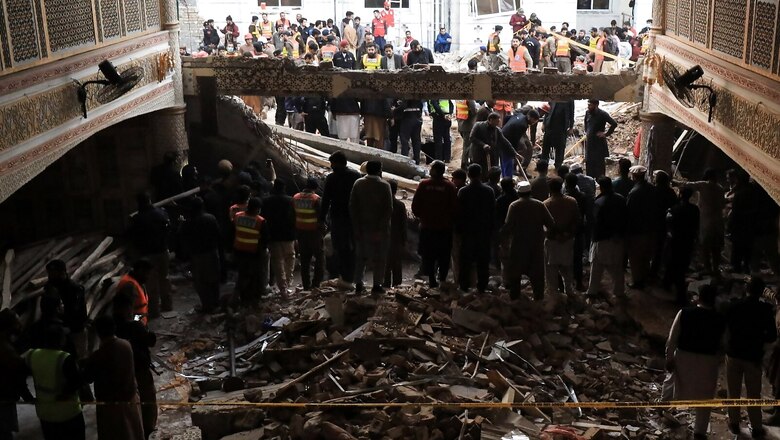
views
Just days after a member of the Pakistani Taliban, or TTP, blew himself up inside a mosque in Peshawar that killed over 100 people, the dreaded militant outfit released a report on its activities carried out in January. It has claimed a total of 46 attacks, in which 49 were killed and 58 injured.
The Tehreek-e-Taliban Pakistan (TTP) released an infographic on its attacks carried out in the neighbouring country in January. The report of the militant attacks in different parts of Pakistan was released by the TTP’s Umar Media.
Here’s a breakup: eight attacks in Dera Ismail Khan; seven in North Waziristan; six in Lakki Marwat; five in Peshawar; four in Khyber agency; three in South Waziristan; two each in Tank and Charsadda; one each in Qilla Abdullah, Pishin, Khanewal, Sorab, Swabi, Dera Ghazi Khan and Quetta. Of these, majority attacks took place in the restive Khyber Pakhtunkhwa province that is close to the Afghanistan border.
The TTP media also claimed that in January, a total of 107 security personnel were hit – 60 policemen, 25 army personnel, 13 from the Frontier Corps and nine from security agencies.
According to the report, the TTP carried out nine target attacks, five grenade/bomb blasts, eight ambush attacks, four assault attacks, eight guerilla attacks, four counter attacks, seven sniper/laser attacks and one suicide attack.
The report came amid reports of another attack in Pakistan’s Punjab province, where heavily-armed TTP militants opened fire at a police station in Mianwali. District police officer Mianwali Muhammad Naveed said around 20 militants armed with automatic weapons attacked the Makerwal police station late on Tuesday but were repulsed by the law enforcement agency, according to Geo TV.
This incident assumes significance because the TTP, which was concentrating its attacks in Khyber Pakhtunkhwa (KP) and Balochistan, has now trained its guns in Punjab. According to a report in news agency PTI, Makerwal in Isakhel tehsil is a mostly hilly area known for coal mines.
2022 was a violent year for Pakistan
Pakistan had the highest number of militant attacks in 2022, with December as its deadliest month coupled with the rise of the Pakistani Taliban. An end to a ceasefire agreement between the TTP and security forces last November resulted in increased terrorist attacks – capital Islamabad saw its first suicide bombing since 2014, in which one police officer and two suspected militants belonging to the outfit were killed on December 23, 2022. Six others, including four policemen, were injured in the bombing in an upscale residential area.
According to data available, Pakistan witnessed four times more suicide attacks than in 2021 – the year in which the Taliban took over neighbouring Afghanistan. There were reports of 15 suicide bombings in 2022 as compared to only four in 2021. This was the highest number of suicide attacks in the country since 2018.
There were at least 376 terror attacks in 2022, in which 533 people were killed and 832 injured. This is for the first time since 2017 that the country faced more than 300 militant attacks. In 2017, Pakistan recorded 420 such attacks in which 912 people were killed.
In December 2022, the Shehbaz Sharif-led government had said the number of TTP fighters in the Pakistan-Afghanistan border area was between 7,000 and 10,000. Those militants, thought to have laid down arms, had also secretly resumed activities, said interior minister Rana Sanaullah Khan.
Pakistan recovering from Peshawar attack
On January 30, a TTP suicide bomber killed over 100 people at a mosque inside a major police facility in Peshawar, which is the capital of the KP province. It is being considered as one of the deadliest attacks carried out in the country in recent years.
On Wednesday, Prime Minister Shehbaz Sharif warned of militants spreading across the country if immediate steps were not taken. Addressing the cabinet, Sharif said terrorism was rearing its head again and people from Peshawar to Karachi had questions about “who brought them (Taliban) back”.
“Everyone is asking who brought them back. What happened? How can peace be destroyed? How can Khyber Pakhtunkhwa go back into the hands of terrorists?” he said.
The prime minister said the KP province had received a massive amount of Rs 417 billion since 2010 but the money was not spent to boost security, adding that the Imran Khan-led Pakistan Tehreek-e-Insaf had ruled the province in the last 10 years.
Why are TTP attacks on the rise once again?
According to PTI, the TTP was set up as an umbrella group of several militant outfits in 2007. In November last year, it called off a ceasefire with the federal government and ordered its militants to stage terrorist attacks across Pakistan especially to target security forces.
The group, which is believed to be close to al-Qaeda, has been blamed for several deadly attacks across Pakistan, including an attack on army headquarters in 2009, assaults on military bases, and the 2008 bombing of the Marriott Hotel in Islamabad.
In 2014, it stormed the Army Public School in Peshawar, killing at least 150 people, including 131 students. It is also responsible for the shooting of Malala Yousafzai, who survived the 2012 attack after she was targeted for her campaign against the Taliban’s efforts to deny women education.
The Peshawar attack only underscores the Pakistani Taliban’s resurgence in recent months. It is being considered as the principal threat to Pakistan, which is already in the throes of an economic as well as political crisis.
(With agency inputs)
Read all the Latest News here


















Comments
0 comment